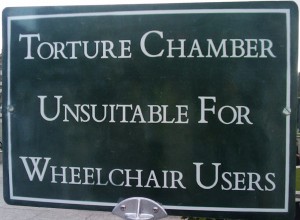You see it all the time. In store windows, in sales circulars, even on television. The core message always boils down to the same thing:
“Buy my crap and save [$x.xx]”
It doesn’t work, and here’s why not.
When you say “Buy now and save [$x.xx]”, what you’re really saying is “Look how generous I am. I’m willing to give up [$x.xx] of my income to make this sale. I’m sacrificing myself for you. You should be thanking me. You should be so grateful that you’ll run in here and shove old ladies out of the way to throw your money at me.”
There are multiple problems with this approach. Let’s look at just a few of them.
1. Whether you are liberal or conservative; whether you belong to this party, that party or the other one; whatever your skin color and regardless of what language you speak or the accent you carry when you speak it; all people, from all walks of life, are tuned to the same frequency: “WIIFM”.
You may be familiar with it already. It stands for “What’s In It For Me”.
In short, I don’t care how supposedly generous you are and I especially don’t care what you’re supposedly giving up. I either need or want what you are trying to sell or I don’t. If I don’t need it, and especially if I don’t want it, then it really doesn’t matter what you’re giving up. I still don’t need it or want it.
2. If you can afford to just slash [$x.xx] off the price then you must have been gouging your customers up to now. That means you will probably try to gouge me too. I don’t trust you and I probably don’t like you either. Even if I’ve never met you.
I don’t believe for one moment that you aren’t still making a profit on this deal (assuming there’s a deal to be made) so you must have been making an obscene profit before.
3. You are putting the focus on price. It’s suddenly no longer about the product or how it can solve my problem or meet my needs. It’s all about the exchange of my cash for your crap.
And yet, mysteriously, these offers almost never tell me what the price actually is. Sure, I know you’ll give me [$x.xx] off, but what am I still paying?
4. Since you’re not telling me the price but you are playing up how generous you are by taking so much off, I’m going to assume (since I already believe you’re still making a profit) that the price is absolutely outrageous. $100 off? That means it must be several hundred or more to begin with, and probably still is.
5. It smacks of desperation. If your product or service were popular and in demand, then you wouldn’t have to discount it. If you offered genuine and unquestionable value, I wouldn’t care what the price was.
So go ahead, keep playing the [$x.xx] off game. I guarantee you’ll lose.
Click any of the icons below to retweet these passages from the above article.
Remember, we’ll donate money to charity for every retweet. No purchase necessary. You retweet, we donate. It’s that simple.
![]() “Buy Now And Save [$x.xx]” is like a backwards magnet that repels customers.
“Buy Now And Save [$x.xx]” is like a backwards magnet that repels customers.
![]() 5 Reasons Why “Buy Now And Save [$x.xx]” Doesn’t Work
5 Reasons Why “Buy Now And Save [$x.xx]” Doesn’t Work
![]() “Buy my crap and save [$x.xx]” doesn’t work, and here’s why not…
“Buy my crap and save [$x.xx]” doesn’t work, and here’s why not…
![]() When you say “Buy Now And Save [$x.xx]”, what you’re really saying is…
When you say “Buy Now And Save [$x.xx]”, what you’re really saying is…
![]() If you do this I don’t trust you and I probably don’t like you either.
If you do this I don’t trust you and I probably don’t like you either.
![]() It’s all about the exchange of my cash for your crap.
It’s all about the exchange of my cash for your crap.
![]() This sales strategy smacks of desperation.
This sales strategy smacks of desperation.
![]() Go ahead, keep playing the [$x.xx] off game. I guarantee you’ll lose.
Go ahead, keep playing the [$x.xx] off game. I guarantee you’ll lose.

 Not everyone thinks of it but knowing who would not make good customers is every bit as important as knowing who does make good customers.
Not everyone thinks of it but knowing who would not make good customers is every bit as important as knowing who does make good customers.